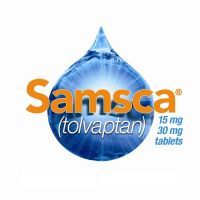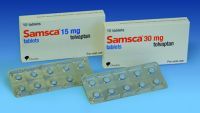Article
Samsca Delivers Electrolytes in Hyponatremia
Author(s):
Approved by the FDA nearly four years ago, Otsuka Group's once-daily Samsca (tolvaptan tablets) is indicated to raise serum sodium levels in nonurgent patients with hyponatremia.

Approved by the FDA nearly four years ago, Otsuka Group’s once-daily Samsca (tolvaptan tablets) is indicated to raise serum sodium levels in nonurgent patients with hyponatremia, an electrolyte abnormality that occurs in roughly 20 percent of hospitalized people in the United States.
According to Otsuka Pharmaceutical Co., Ltd., Samsca is the “only oral selective vasopressin antagonist for the treatment of patients with clinically significant hypervolemic and euvolemic hyponatremia, including patients with congestive heart failure, liver cirrhoisis and the syndrome of inappropriate antidiuretic hormone (SIADH).”
Symptoms associated with hyponatremia depend on the speed of its onset, as the rapid occurrence of low salt levels in body fluids can cause confusion, coma and seizures, while the more slowly developing condition may result in muscle cramps and headaches. In patients with chronic hyponatremia, symptoms include posture impairment, unsteadiness, attention deficits and increased falls. Irritability, weakness and nausea and vomiting have also appeared in hyponatremia patients across the board.
Pharmacology and Pharmacokinetics
The full prescribing information for Samsca notes “15- to 60-milligram doses of tolvaptan antagonize the effect of vasopressin and cause an increase in urine water excretion that results in an increase in free water clearance, a decrease in urine osmolality and a resulting increase in serum sodium concentrations.”
The aquaretic and sodium-increasing effects’ onset is observed within two to four hours following oral administration, while P-glycoprotein substrate and inhibitor tolvaptan highly binds to plasma protein. However, a peak in serum sodium concentration and urination rate is not observed until between four and eight hours after a dose, which means “the pharmacological activity lags behind the plasma concentrations of tolvaptan.” Twenty-four hours after dose administration, 60 percent of the serum sodium’s peak effect is sustained, though the urination rate is no longer elevated at that time.
Tolvaptan is mainly metabolized by Cytochrome P450 3A4 enzymes and eliminated by non-renal routes, though the onset and offset of tolvaptan’s effect on serum sodium levels are slower in patients with severe renal impairment.
While moderate or severe heptic impairment or congestive heart failure in patients increase the drug’s distribution volume and decrease its clearance, the changes are not clinically relevant.
Dosage and Administration

Samsca is available in 15-milligram and 30-milligram tablets administered without regard to food. After at least 24 hours without fluid restriction following a typical 15-milligram starting dose, Samsca can be taken in 30-milligram tablets, up to a maximum 60-milligram daily dosage, to achieve a desired serum sodium level.
Both forms of Samsca are non-scored, shallow-convex, blue triangular tablets debossed with “OTSUKA” and their respective measures on one side.
Since overly rapid correction of hyponatremia can cause osmotic demyelination syndrome or related neurological sequelae — resulting dysphagia, involuntary muscle weakness, seizures, coma and death — Samsca should only be administered and re-initiated in a hospital where a patient’s serum sodium can be closely monitored.
Clinical Trials
In two placebo-controlled, double-blind clinical studies of patients with euvolemic or hypervolemic hyponatremia resulting from various underlying causes — such as heart failure, cirrhosis and SIADH — Samsca was shown to significantly increase serum sodium concentrations as early as eight hours after the first dose, and that change was sustained for a month with daily dosage.
During the trials, 25 percent of the 206 patients in the placebo group required fluid restriction, while only 14 percent of the 215 patients in the tolvaptan group needed that restriction. Serum sodium levels in the Samsca-treated patients decreased to concentrations similar to the placebo-treated patients seven days after the drug’s withdrawal.
Contraindications, Warnings and Precautions
As tolvaptan is metabolized by CYP 3A, Samsca is contraindicated in patients with concomitant use of strong CYP 3A inhibitors, such as clarithromycin, ketoconazole, ritonavir and telithromycin. Samsca is also contraindicated in patients requiring urgent intervention to raise serum sodium in order to avoid or treat serious neurological symptoms, as well as patients who are unable to urinate or sense or appropriately respond to thirst.
No overall differences were observed between elderly and younger age groups in the clinical trials, but the safety and effectiveness of Samsca have not been established in the pediatric population.
Commonly observed adverse reactions to Samsca include thirst, dry mouth, asthenia, constipation, hyperglycemia and pollakiuria or polyuria.


